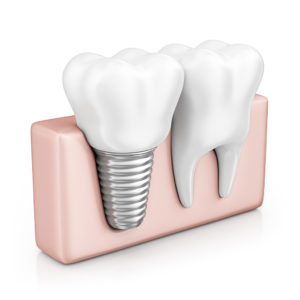 What Are Dental Implants?
What Are Dental Implants?
Dental implants are a dental procedure and apparatus specifically designed to replace individual teeth. The result is a natural looking tooth crown. Implants are made of several individual elements; the actual implant which is integrated into the maxillary and mandibular bones, an abutment which is designed to fit on top of the portion of the titanium that can be seen above the gumline, and finally the artificial tooth looking crown. The crown is designed to look exactly like the missing natural tooth and is formulated by your restorative dentist and then attached onto the abutment. The final product will give the appearance of anatomy as well as the physiology of the natural teeth. The key ingredient in the success of dental implants is osseointegration. Osseointegration is a process involving the natural existing bone growing up to the surface of the titanium implant. Titanium has been chosen by dentists as the key material for implants due to it’s osseointegrative properties.
Am I a Candidate for Dental Implants?
Dental implant surgery can be performed on close to anyone that is missing a tooth, teeth, or that has teeth that are designated for extraction. The presence of healthy mandibular or maxillary bones are required to stabilize the implant under the forces involved with daily life and eating. The following is a list of indications for dental implant surgery:
Periodontal Disease; When gingivitis (disease of the gums with no bone loss) progresses to periodontitis (gum disease including loss of bone structure or loss of the attachment apparatus) can be damaging to the tooth attachment apparatus in such a fashion that the teeth are either lost or are required to be extracted. Surgery in these cases are generally successful as long as the existing alveolar bone is healthy enough to support the implant.
Implants vs. Dentures; Implants are versatile in these situations and can be used as an alternative, a replacements, or a stabilization mechanism for partial dentures.
Chipped, missing, or cracked teeth; Many of these situations can be successfully resolved using a dental implant procedure. Whatever the etiology (decay, trauma, etc.) the teeth that cannot be otherwise repaired can benefit from this procedure.
What is the Procedure?
The process of placing dental implants begins with a careful plan for surgery. Before surgery begins a plan is needed to take vital structures such as existing maxillary and mandibular bone, any nearby nerves, and structures like the maxillary sinus into account. Furthermore, the exact form of the existing bone structure needs to be viewed and observed in order to install the implant for the best and most successful possible results. X-rays, MRI’s, or CT scans can be analyzed to provide for the most accurate information available.
The first step in the surgery is an entrance into the bone. This can be done using specific drills. The implant is then placed into the bone. A certain amount of time is then given in order for the implant and the bone to undergo osseointegration. Temporary crowns can be used in order to maintain asthetics during this wait time.
The allotted time for osseointegration of the implant and the alveolar bone is constantly under debate and there has not yet been any specific number agreed upon at this time. With this taken into consideration, the time that is required to pass for a practicioner to allow implants to heal before the commencement of the surgery and final placement of the abutment and crown can have a wide range. Two to six months is a general range that the practitioners will allow for healing. Several studies have shown the problematic nature of cutting the time for healing too short.
What is the Longevity of Dental Implants?
In an ideal situation, implants are permanent. The strength resulting from the osseointegration and materials used provides for a long life for the implant.
Are there Specific Care Instructions?
Dental Implants should be treated just as the natural teeth should be. Proper care and regular dental visits are essential for the avoidance of problematic situations. Even though the surgery removes the periodontal ligament from the tooth and the attachment is secure, gingival problems can still arise and should be avoided.



